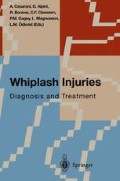Abstract
Training focused on the primary functional problems and secondary adaptive strategies of the individual can have positive effects on postural stability in postwhiplash vertigo and dizziness. The most effective training program, however, incorporates all the information from the patient’s history, physical examination, clinical and instrumental test results.
Access this chapter
Tax calculation will be finalised at checkout
Purchases are for personal use only
Preview
Unable to display preview. Download preview PDF.
References
Albus J S (1971) A theory of cerebellar function. Mathemathical Biosciences 10:26–61
Ashby WR (1956) An introduction to cybernetics. Chapman & Hall Ltd, London
Basar E (1980) EEG-brain dynamics. Elsevier, Amsterdam
Bertalanffy L von (1962) General system theory. A critical review. General System Yearbook 7:1–20
Cherry C (1961) On human communication. Science Ed, New York
Cesarani A, Pedotti A, Alpini D (1994) General system theory. A cybernetic basis for modern rehabilitaion treatment of equilibrium disorders. In: Claussen CF, Kirtane MV, Schneider D (eds). Vertigo, nausea, tinnitus and hypoacusia due to central disequilibrium. Edition m+p, Hamburg, p 53
Cesarani A, Pedotti A, Alpini A (1994) General system theory. A cybernetic basis for rehabilitative treatment of balance disorders. In: Claussen CF, Kirtane MV, Schneider D (eds). Vertigo, nausea, tinnitus and hypoacusia due to central disequilibrium. Medicin + Pharmacie, Dr Werner Rudat & Co, Nachf, Hamburg
Davies PM (1993) Steps to follow. Springer, Heidelberg, Berlin, New York, Tokyo
Dilts R, Grinder J, Bandler R, Bandler LC, De Lozier J (1980) Neurolinguistic programming. Meta Publication, Cupertino, California
Fujita M (1982) Adapative filter model of the cerebellum. Biological Cybernetics 45:195–206
Fujiita M (1982) Simulation of adaptive modification of the vestibulo-ocular reflex with an adaptive filter model of the cerebellum. Biological Cybernetics 45:207–214
George FH (1962) The brain as a computer. Pergamon, Oxford
Gluck MA, Rumelhart DE (1990) Neuroscience and connectionist theory. Lawrence Erlbaum Associates, Hillsdale, New Jersey
Ito M (1982) Cerebellar control of the vestibulo-ocular reflex around the flocculus hypothesis. Annual Rev of Neuroc 5:275–296
Ito M (1984) The cerebellum and neural control. New York, Raven
Marr D (1969) A theory of cerebellar cortex. J Physiol 202:437–470
Mc Culloch WS, Pitts W (1943) A logical calculus of the ideas imminent in nervous activity. Bull Math Biophys 5:115
Robinson DA (1976) Adaptive gain control of vestibulo-ocular reflex by the cerebellum. J Neurophys 39(5):954–969
Watzlawich P, Beavin JH, Jackson DD (1967) Pragmatic of human communication. W Norton, New York
Author information
Authors and Affiliations
Editor information
Editors and Affiliations
Rights and permissions
Copyright information
© 1996 Springer-Verlag Italia
About this paper
Cite this paper
Cesarani, A., Alpini, D. (1996). The Therapeutic Strategy. In: Cesarani, A., et al. Whiplash Injuries. Springer, Milano. https://doi.org/10.1007/978-88-470-2293-5_29
Download citation
DOI: https://doi.org/10.1007/978-88-470-2293-5_29
Publisher Name: Springer, Milano
Print ISBN: 978-88-470-2295-9
Online ISBN: 978-88-470-2293-5
eBook Packages: Springer Book Archive

